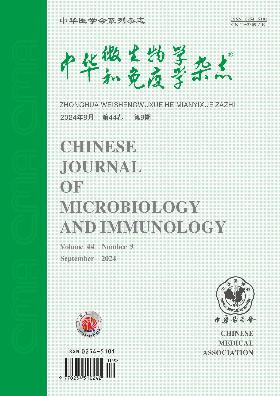格图病毒重组截短糖蛋白的表达及抗体制备
Q4 Immunology and Microbiology
引用次数: 1
摘要
目的在大肠杆菌(E.coli)细胞中表达格尔图病毒(GTV)的截短糖蛋白(Gn、Gn1、Gn2、Gn3、Gc1和Gc2),纯化后制备抗重组蛋白Gn- his、Gc1- his和Gc2- his的多克隆抗体。方法采用RT-PCR扩增GTV DXM菌株Gn、Gn1、Gn2、Gn3、Gc1和Gc2基因片段,克隆到原核表达载体pET-32a(+)上,构建重组表达质粒。转化后的大肠杆菌BL21(DE3)携带表达质粒,IPTG诱导其表达目标蛋白,SDS-PAGE鉴定目标蛋白。重组蛋白Gn-His、Gc1-His和Gc2-His经镍亲和层析纯化,用gtv阳性羊血清进行Western blot检测,分析其抗原性。用纯化的重组蛋白免疫新西兰大白兔。ELISA法分析血清抗体滴度和特异性。同时构建真核表达载体pcDNA3.1-Gn、pcDNA3.1-Gc1/Gc2,转染哺乳动物Vero细胞,采用间接免疫荧光法评价兔多克隆抗体的结合活性。Western blot检测血清抗体对重组蛋白的特异性反应性。结果酶切分析和DNA测序证实,成功构建了pET-32a-Gn、pET-32a-Gn1/Gn2/Gn3、pET-32a-Gc1/Gc2、pcDNA3.1-Gn和pcDNA3.1-Gc1/Gc2重组表达载体。表达的重组蛋白Gn-His、Gn1/Gn2/Gn3-His、Gc1/Gc2-His的相对分子质量(Mr)分别约为63.4×103、37.1×103、31.9×103、30.8×103、40×103和54.4×103。重组蛋白可被gtv阳性绵羊血清识别。GTV Gn、Gc1和Gc2多克隆抗体滴度分别为1∶409 600、1∶204 800和1∶6 400。间接免疫荧光和Western blot结果表明,制备的兔多克隆抗体能与真核细胞中表达的蛋白和重组蛋白发生特异性反应。结论重组GTV糖蛋白Gn-His和Gc1/Gc2-His得到了高效表达和纯化,具有良好的免疫特性。制备的多克隆抗体滴度高,特异性好。本研究为进一步研究GTV糖蛋白的生物学功能、检测方法及疫苗研究提供参考。关键词:Guertu病毒;糖蛋白;原核表达;真核表达;兔多克隆抗体本文章由计算机程序翻译,如有差异,请以英文原文为准。
Expression and antibody preparation of recombinant truncated glycoprotein of Guertu virus
Objective
To express truncated glycoprotein (Gn, Gn1, Gn2, Gn3, Gc1 and Gc2) of Guertu virus (GTV) in Escherichia coli (E.coli) cells, and prepare polyclonal antibodies against recombinant proteins Gn-His, Gc1-His and Gc2-His after purification.
Methods
Gene fragments encoding Gn, Gn1, Gn2, Gn3, Gc1 and Gc2 of GTV DXM strain were amplified by RT-PCR, and cloned into the prokaryotic expression vector pET-32a (+ ) to construct recombinant expression plasmids. The transformed E. coli BL21(DE3) strains carrying expression plasmids were induced by IPTG to express target proteins, which were identified by SDS-PAGE. Recombinant proteins Gn-His, Gc1-His and Gc2-His were purified by nickel affinity chromatography and detected by Western blot using GTV-positive sheep serum for analysis of their antigenicity. New Zealand white rabbits were immunized with the purified recombinant proteins. The titers and specificity of serum antibodies were analyzed by ELISA. Meanwhile, eukaryotic expression vectors pcDNA3.1-Gn, pcDNA3.1-Gc1/Gc2 were constructed and transfected into mammalian Vero cells to evaluate the binding activity of rabbit polyclonal antibodies by indirect immunofluorescence method. The specific reactivity of serum antibodies to recombinant proteins was detected by Western blot.
Results
Restriction enzyme analysis and DNA sequencing confirmed that the recombinant expression vectors of pET-32a-Gn, pET-32a-Gn1/Gn2/Gn3, pET-32a-Gc1/Gc2, pcDNA3.1-Gn and pcDNA3.1-Gc1/Gc2 were constructed successfully. The relative molecular mass (Mr) of the expressed recombinant proteins Gn-His, Gn1/Gn2/Gn3-His, Gc1/Gc2-His were approximately 63.4×103, 37.1×103, 31.9×103, 30.8×103, 40×103 and 54.4×103, respectively. The recombinant proteins could be recognized by GTV-positive sheep serum. The titers of polyclonal antibodies against GTV Gn, Gc1 and Gc2 were 1∶409 600, 1∶204 800 and 1∶6 400, respectively. Indirect immunofluorescence assay and Western blot showed that the prepared rabbit polyclonal antibodies could specifically react with the proteins expressed in eukaryotic cells and the recombinant proteins.
Conclusions
The recombinant GTV glycoproteins Gn-His and Gc1/Gc2-His were efficiently expressed and purified and characterized with good immunity. The prepared polyclonal antibodies had high titers and good specificity. This study provided reference for further studying the biological function and detection methods of GTV glycoproteins and research on vaccines.
Key words:
Guertu Virus; Glycoprotein; Prokaryotic expression; Eukaryotic expression; Rabbit polyclonal antibody
求助全文
通过发布文献求助,成功后即可免费获取论文全文。
去求助
来源期刊

中华微生物学和免疫学杂志
Immunology and Microbiology-Virology
CiteScore
0.50
自引率
0.00%
发文量
6906
期刊介绍:
Chinese Journal of Microbiology and Immunology established in 1981. It is one of the series of journal sponsored by Chinese Medical Association. The aim of this journal is to spread and exchange the scientific achievements and practical experience in order to promote the development of medical microbiology and immunology. Its main contents comprise academic thesis, brief reports, reviews, summaries, news of meetings, book reviews and trends of home and abroad in this field. The distinguishing feature of the journal is to give the priority to the reports on the research of basic theory, and take account of the reports on clinical and practical skills.
 求助内容:
求助内容: 应助结果提醒方式:
应助结果提醒方式:


